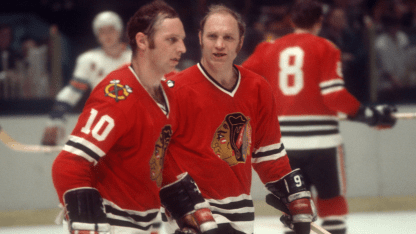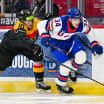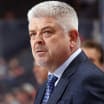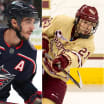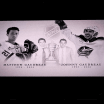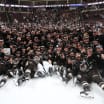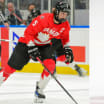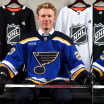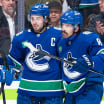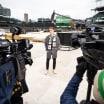Legendary hockey reporter Stan Fischler writes a weekly scrapbook for NHL.com. Fischler, known as "The Hockey Maven," shares his humor and insight with readers every Wednesday.
This week features six of his favorite brother acts from yesteryear. In each case, the brothers played on the same team during their NHL careers, but one pair actually predated the League and later starred for the Montreal Canadiens.
Among all the major sports, none can compare with hockey when it comes to having starry brother acts not only in the NHL, but on the same team as well. The following are my six favorite pairs from the past (in alphabetical order).
1. MAX AND DOUG BENTLEY: When they were teammates on the Chicago Black Hawks in the early 1940s, Max was the center on a razzle-dazzle line with Doug at left wing and Bill "Wee Willie" Mosienko on the right side. Since they had plenty of giddyap, it was appropriately nicknamed "The Pony Line" and all three eventually were inducted into the Hockey Hall of Fame.
Speedy Max skated -- as one scribe called it -- "like a water bug on a pond" while Doug was a master playmaker and shooter. They never played for a Stanley Cup winner and on Nov. 2, 1947, Max was traded to the Toronto Maple Leafs for five players. Doug and Max were briefly reunited with the New York Rangers late in the 1953-54 season and still showed signs of their prowess.
2. SPRAGUE AND ODIE CLEGHORN: The Cleghorns did not play hockey according to Good Housekeeping magazine rules. Yet their dual talents were so high-class that they
were the first outstanding Canadian stickhandlers to be invited to play in New York for the Wanderers when pro hockey was in its infancy. Manhattan journalists lauded them for their excellence but also faulted their excessive rough play at their home rink, St. Nicholas Arena in Manhattan, not far from Times Square.
As NHL pros, they starred for the Montreal Canadiens from 1921-22 through 1924-25. Odie played forward and did so with less boisterousness than Sprague, a defenseman and Hall of Famer. The latter symbolized the violent style of "Old Time Hockey," and considered intimidation and rugged individualism as keys to his success.
The pair were the closest of siblings. On July 14, 1956, two days after Sprague's death and when his funeral was about to commence, Odie was found dead of a heart attack.
3. BILL AND 'BUN' COOK: Admired for their creativity in Western Canadian hockey circles, the Cooks were lured to the NHL when the Rangers were organized in the fall of 1926. The Rangers' original talent scout, Conn Smythe, had seen the Cooks in action and persuaded them to skate for the second New York-based NHL team. Smythe was fired before the Cooks' inaugural season began, but new general manager Lester Patrick realized that he had a pair of aces.
Patrick wisely added another Smythe find, Frank Boucher, to the unit and in no time, they were labelled "The Bread Line." Bill Cook, a decorated World War I hero, became team captain and helped the Rangers to the Stanley Cup in 1928 and 1933. Kid brother Fred was such a splendid in-and-out speedster that he was nicknamed "Bunny" -- as in rabbit -- which soon was shortened to Bun.
The final piece of the offensive puzzle, Boucher, flowered with the Cooks. Boucher earned the monicker "Raffles" after the then-famed fictitious British safecracker, He excelled at passing and clean play, winning the Lady Byng Trophy so many times (seven) that Lady Byng finally gave him the original silverware and had another second Byng prize created for other winners.
4. BOBBY AND DENNIS HULL: After too many years near the bottom of the six-team NHL, the Black Hawks began their climb to respectability in the late 1950s with the arrival of left wing Bobby Hull. A powerful skater, armed with a frighteningly lethal shot, the handsome, young ace soon became the face of the NHL. Along with teammate Stan Mikita, Hull introduced the curved stick as a further weapon to torment goalies and in 1961, his Windy City sextet won the Cup for the first time since 1938.
Younger brother Dennis joined the Black Hawks in 1964 and was immediately overshadowed by "The Golden Jet." A natural wit, something he later would turn into standup comedy, the younger Hull felt significant pressure skating in his brother's shadow. Dennis wasn't as strong as Bobby, nor could he dominate a game in the Jet's manner, but he was a solid second line forward who could become a scoring threat.
In the seven-year period as teammates (1964-71), they had 550 goals and 1,032 points. As a brother act, they peaked during the 1968-69 season with a combined 88 goals and 171 points. Missing, unfortunately, was a second Stanley Cup title during their delightful reign.
5. DON AND NICK METZ: There never has been a family twosome that could match these siblings from Wilcox, Saskatchewan, nor the irony of their production. Nick, the elder Metz, became a full-time Maple Leaf in the late 1930s and was renowned as a penalty-killer extraordinaire and an all-round utility forward.
"If there was a job to be done," said Smythe, owner of the Maple Leafs, "Nick was there to do it."
By contrast, Don had a lot to do to gain a full-time job with Toronto Leafs.
"I sent him down to the American League a lot of times," Smythe said, "but I also knew that when I'd recall him, Don would somehow come through. He had that knack."
It first became obvious during the 1942 Stanley Cup Final between Toronto and the Detroit Red Wings. Down 3-0 in the best-of-7 series, Maple Leafs coach Hap Day benched his leading scorer, Gordie Drillon, and replaced him with Don. Miraculously, the younger Metz became one of the aces who paced Toronto to an unprecedented four-game winning streak and the Cup.
Perhaps the most amazing aspect of Don's career is that he never played a single full season with the Maple Leafs yet played on five Stanley Cup winners. Hall of Famers Turk Broda and Ted Kennedy were the only ones in team history to match that feat.
Nick, who never had to be dispatched to the minors, won the Cup four times compared to Don's five.
6. MAURICE AND HENRI RICHARD: In a sense, the contrast between the Richards and the Metz brothers has some similarities. For one thing, Maurice, aptly nicknamed "The Rocket," has gone down in hockey history as the most explosive, not to mention tempestuous, player of all time. On the other hand, Henri was so quiet that Canadiens coach Toe Blake once opined, "I don't know what language he speaks because I never hear a peep out of him."
Maurice already was a 50-goals-in-50 games record breaker and three-time Stanley Cup winner before Henri made it to the NHL at the start of the 1955-56 season.
"I expected to send him back to our junior team," Canadiens coach Toe Blake said, "but he wouldn't let me because he was the best player at every training camp practice."
Blake paired Henri with big brother Maurice and future Hall of Fame left wing Dickie Moore. They were a hit from their first game.
"This was Blake's first year behind the bench," said Canadiens managing director Frank Selke Sr., "and Toe had a good influence on the Rocket. So did Henri. At first Rocket thought he had to protect the kid, but Henri did not need anyone to guard him."
With little fuss and fanfare considering his accomplishment, Henri wound up playing for 11 Stanley Cup winners, more than any other NHL player including his older brother. One of their most admirable feats was skating on the only NHL team (1956-60) to win the Cup in five consecutive seasons.
